In his second venture as a national team head coach, Roberto Martínez has one of the most talented teams in the world at his disposal: Portugal. In a team full of stars like Cristiano Ronaldo, Bernardo Silva, Bruno Fernandes, and Rafael Leão, Portugal continue unbeaten with eight games and eight wins. In fact, in the UEFA Euro 2024 Qualifiers, Portugal are the leaders, not only in their group but as the overall leader, with more points than any other national team, 24.
What is being highlighted in Portugal’s performances is the balance of having the ability to score and not concede. They’ve scored 32 in eight games, giving an incredible average of four goals per game. Moreover, Ronaldo and Fernandes, captain of Manchester United, are making a massive direct contribution to their team’s offensive process, indicating Martínez’s success at getting the most out of his key players. Ronaldo is the second-best goalscorer in the competition with nine goals, while Fernandes leads the assists with eight.
On the other hand, they have been capable of maintaining an almost immaculate defensive record, with two goals suffered in eight games. As we’re going to detail, this is primarily due to both Portugal’s possession domain and to some very important individualities like Diogo Costa, João Palhinha and the UEFA Champions League winner for Manchester City Rúben Dias.
In this tactical analysis, we will try to dissect Roberto Martínez’s ideas and their impact on Portugal’s recent performances.
Offensive process
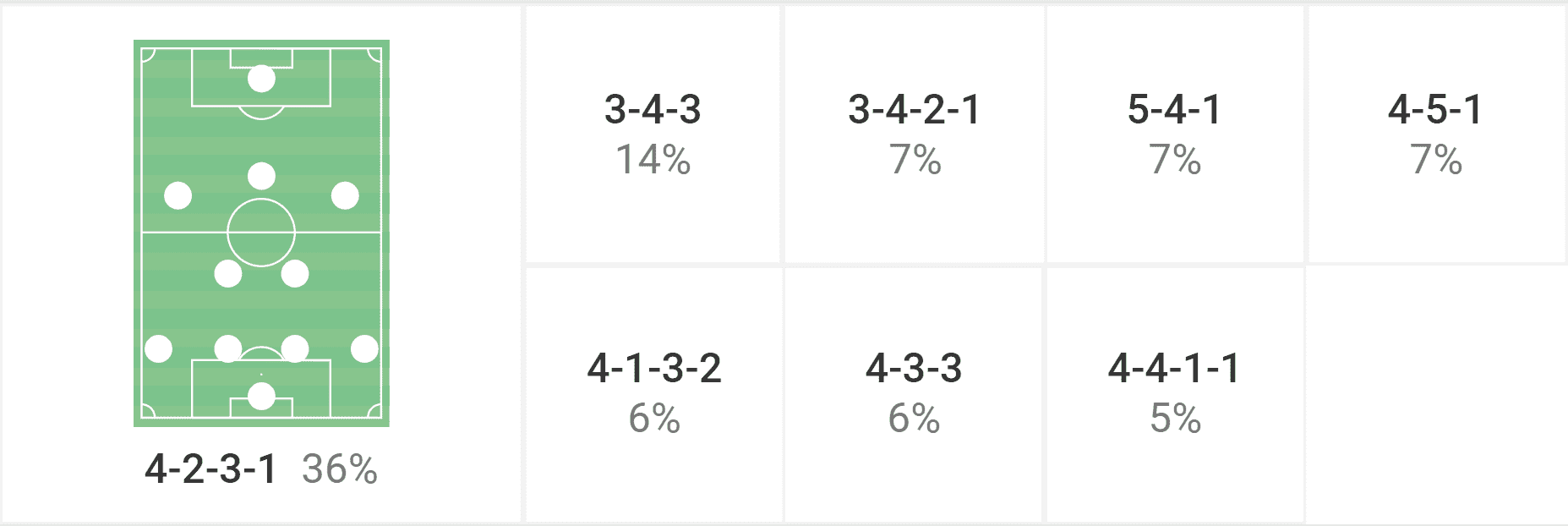
As is visible above, Portugal’s tactics are quite unstable due to their inner dynamics on and off the ball, yet as a general system, they use the 4-3-3. Let’s now try to detail some of their on-the-ball behaviour and explain the image above.
The manager’s philosophy is ruled by a team that believes that by having the ball, they increase significantly their odds of hurting the opposition. With that said, this process generally starts in the goalkeeper, where both centre-backs are wide, and the pivot is positioned ahead of them.
Yet, just like is typical in Martínez’s teams, the pivot often enters the backline whenever they have progressed more in the field.
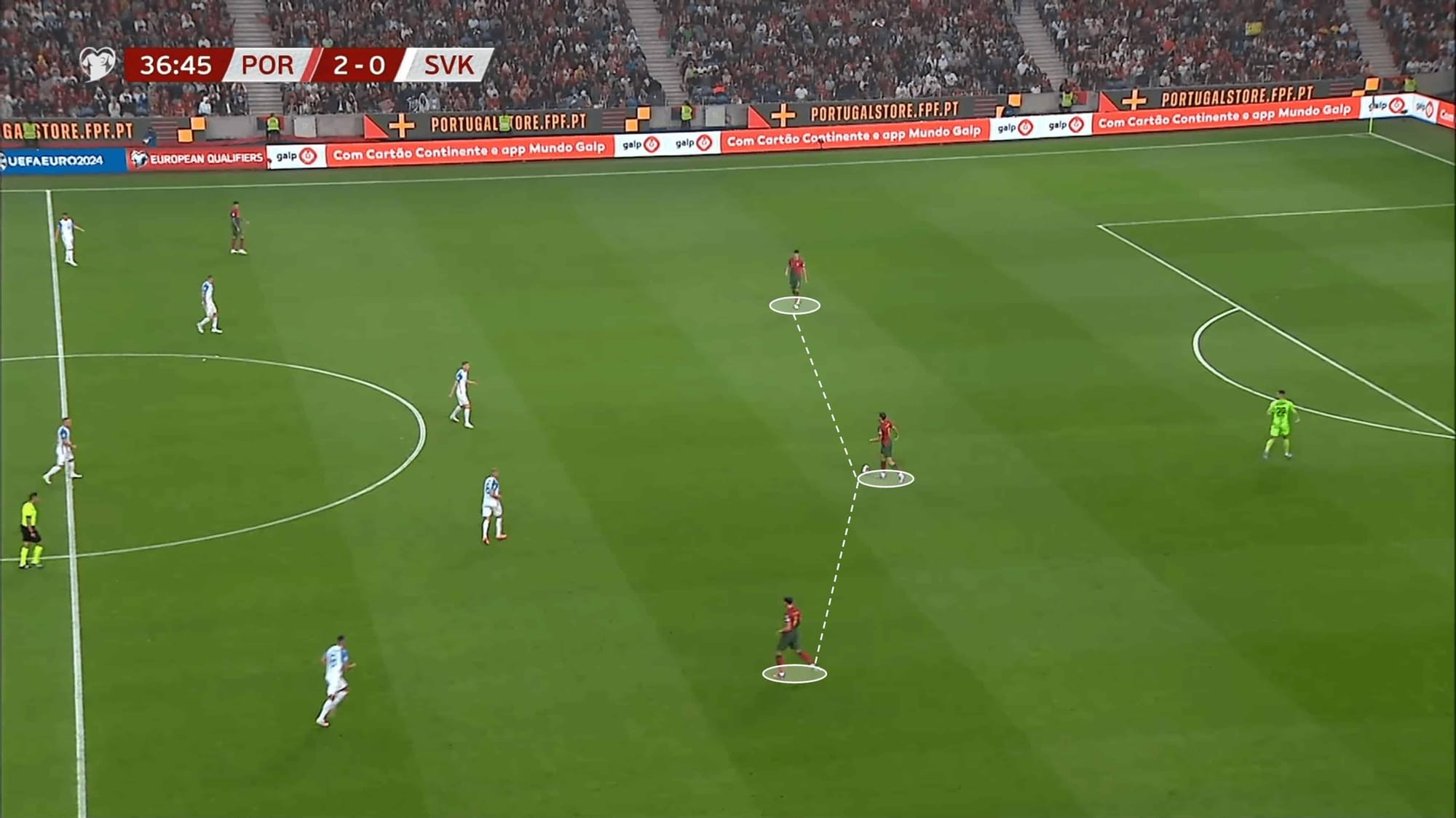
In the course of our analysis, we conclude that the defensive midfielder will be one of the most unpredictable and volatile positions since Martínez has three top players: João Palhinha, Danilo Pereira, Rúben Neves and the youngster João Neves.
Although Palhinha isn’t a very technical pivot, the build-up isn’t his best feature; as we’ll detail, he’s been tremendously crucial for Portugal’s defensive record.
The national head coach can use his different alternatives for distinct types of sides, for example, against a theoretically weaker side. Maybe a player like Pereira or Neves would be more appropriate due to their technical ability and capacity to break lines. On the other hand, if they are facing a much stronger side, then we think that Palhinha would be a more accurate choice.
In this system, the full-backs are wide and deep on the field with the possibility to explore the space inside, especially when players like João Cancelo, Diogo Dalot and Raphaël Guerreiro are used to playing there.
The mobility and Martínez’s range of alternatives while playing are due to the ability of their players to read the game. One example has to do with the fullback-pivot coordination in an initial phase. The usual three-man building elements can alter in the course of the game, and one interesting variant is the inclusion of Cancelo (in this case) in such a block.
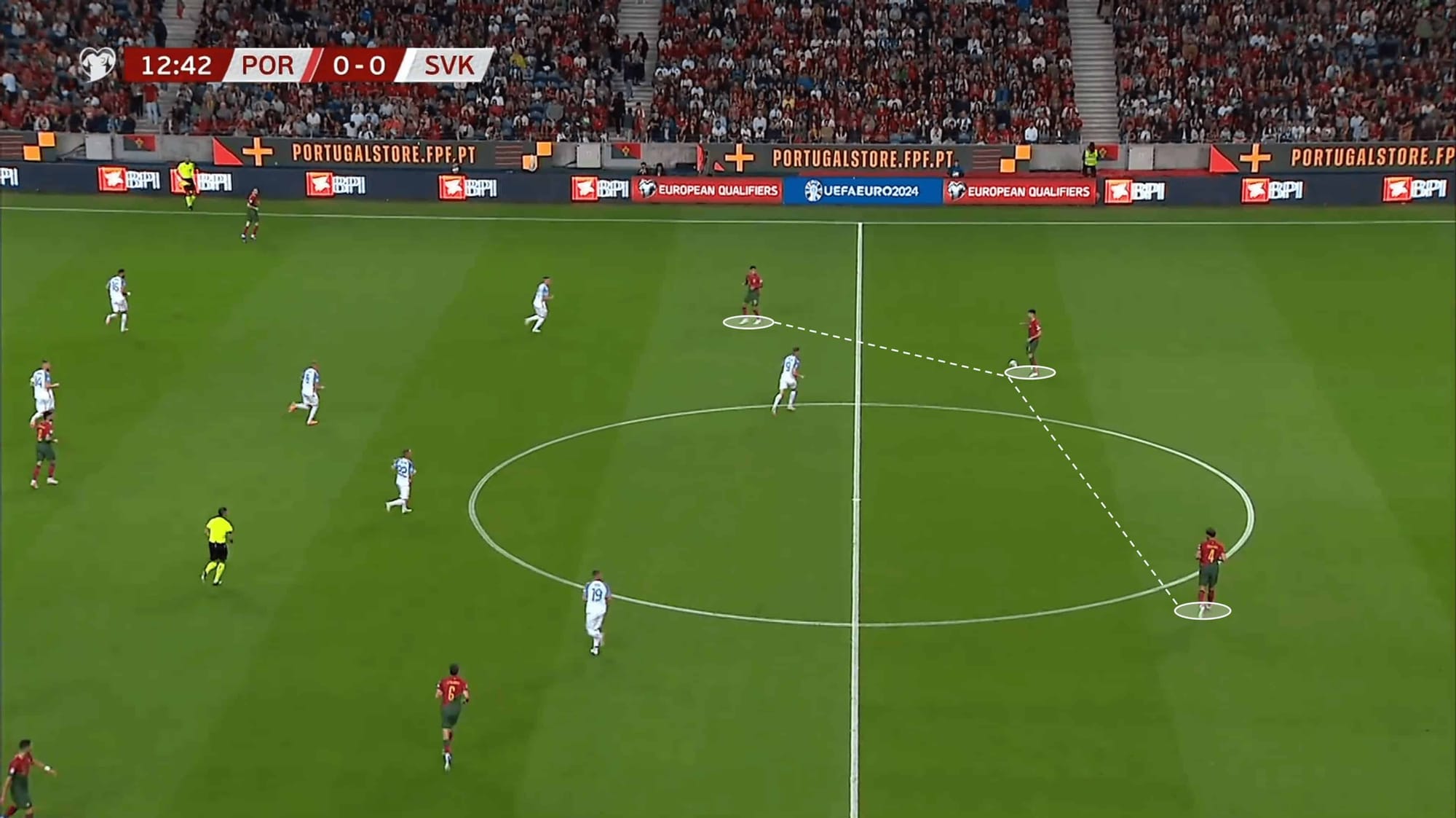
With this comes the adaptability we referred to previously, and Silva immediately adjusts his positioning by descending and lowering his positioning. When this happens, Portugal forms a 3-3-4 or a 3-4-3 if one of the midfielders descends.
As we see it, the most interesting feature of Portugal’s game is related to the positional dynamic between the attackers and the two more advanced midfielders. In fact, Martínez seems to like the idea of using the maximum depth possible, not only to force the opposition to decrease their block but also to create space to play and link.
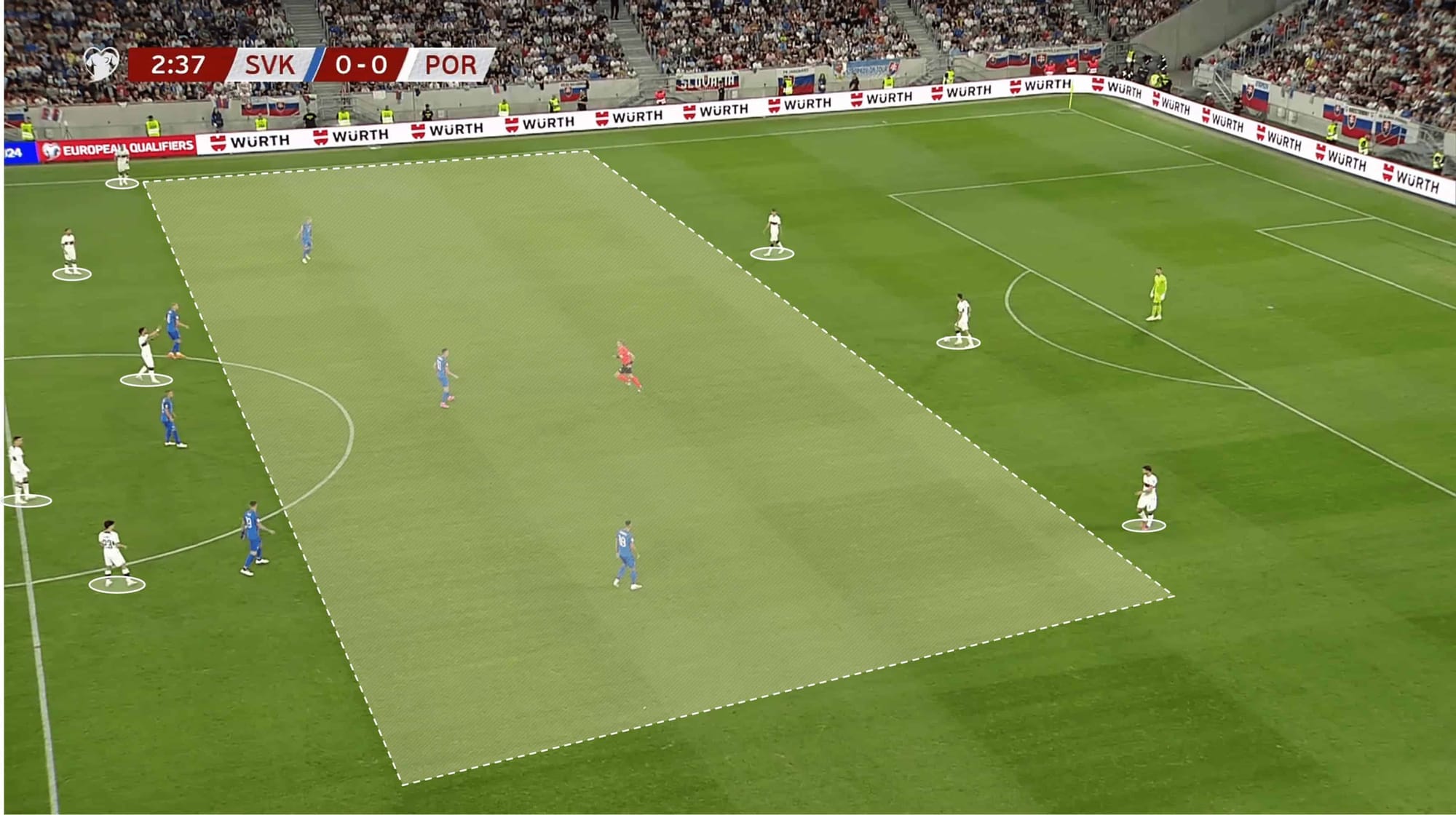
We found this strategy particularly useful due to a critical factor: mobility. As we mentioned in other scout reports, mobility creates space to play. In this case, by being deep, a quick descending movement will give the possibility to link successfully and progress on the field.
This is important to mention because we don’t believe that by having players positioned between the lines, you will successfully link through a direct pass with such elements. Players attract other players, and if Martínez directly intended to link with elements positioned in such space, then the odds of progressing would decrease. That’s why having several alternatives while playing is vital to Portugal and any other team.
Also, the Portuguese can share the short front space quite well, mainly due to the coach’s vision of using players’ characteristics in a specific zone of the pitch. For example, Silva is often seen playing more inside on the right, while on the left, Leão is seen wider.
Besides the build-up, as we told Cancelo and the other full-backs, they are free to explore the interior game. Similar to what we described with Silva, Rafael Leão is quite influential at this stage by descending and by giving solutions wide open to the centre-back.
Although Leão is one of the best players in the world, we don´t think this positioning is the most rentable to his individual and collective performance. The attacker is a risk-taker and is used to upset his opponents with his outstanding dribble and technical movements, and being positioned in such a low zone of the pitch can lead to some turnovers in dangerous zones. Yet, we totally understand Martínez’s intentions in introducing such a movement in Leaõ’s game.
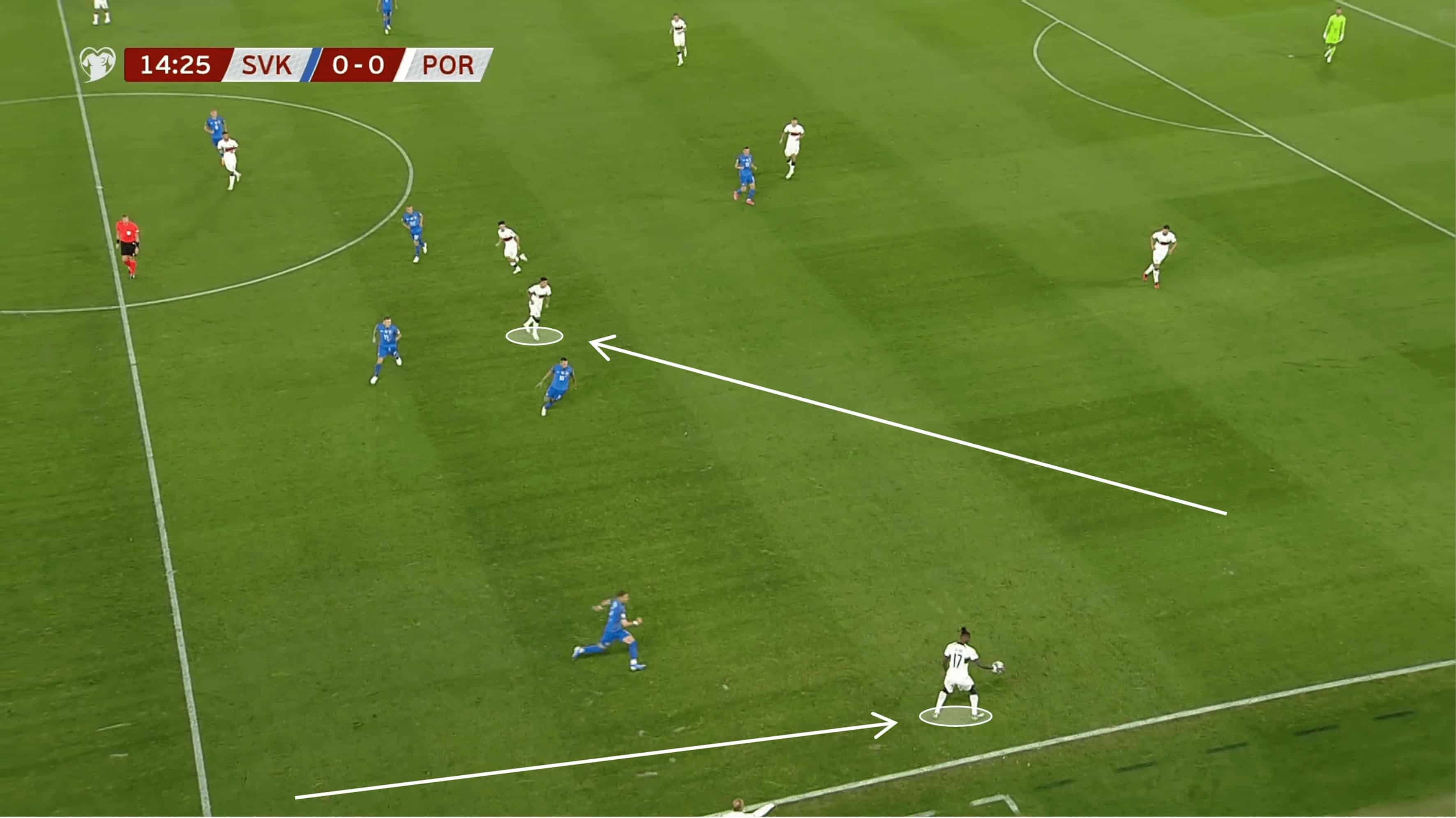
More advanced on the pitch, the Portuguese have the highest finishing rate in Europe, with an average of four goals per game. As we see it, this has some motives attached to it, but one of the biggest reasons has to do with the perfect link between Fernandes and Bernardo Silva.
They understand each other perfectly while playing the right wing. A very common move is Fernandes’s inside cut and a through ball from Silva, who, by being wide, opens a centre-back/full-back gap.
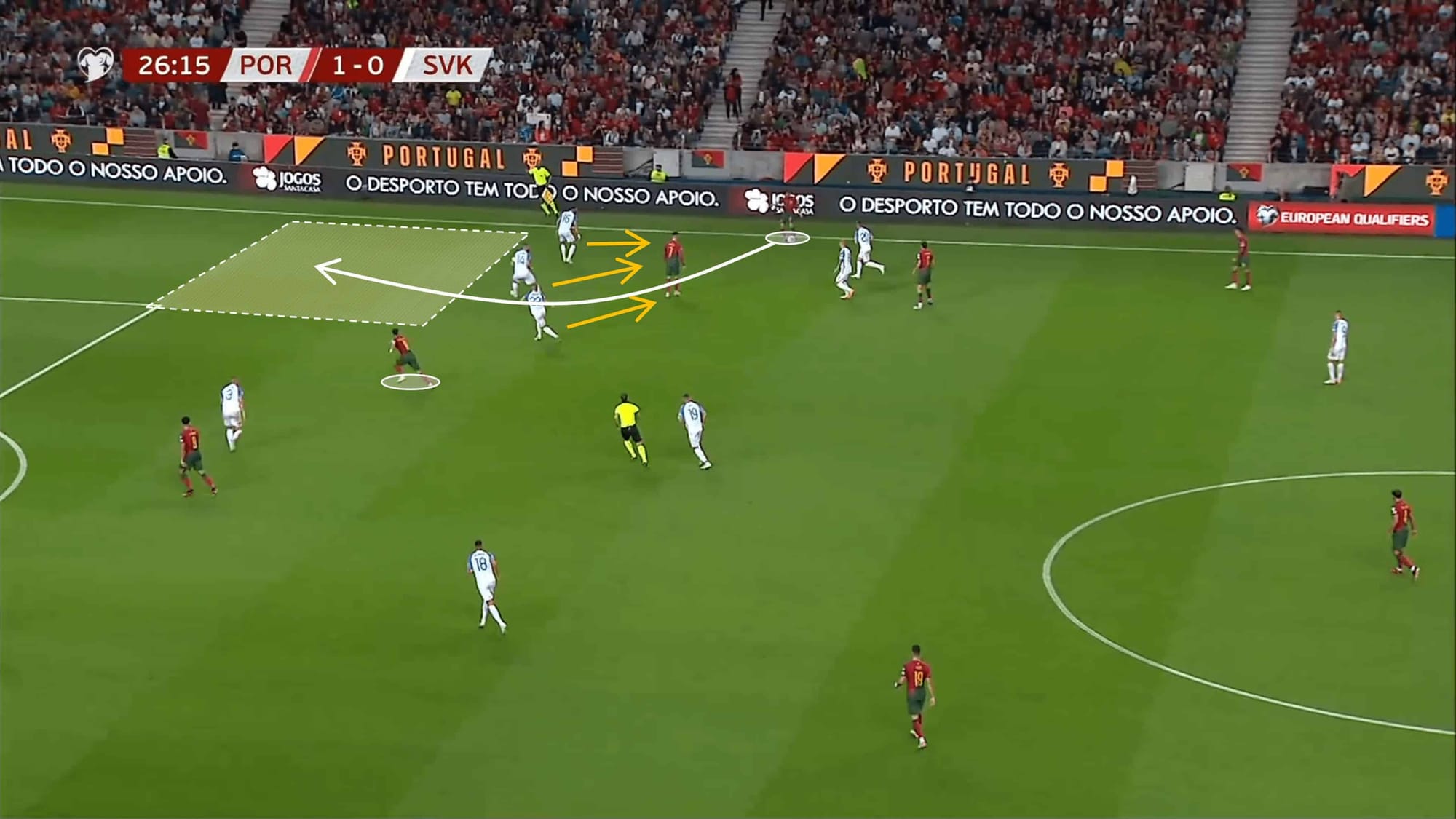
We can’t discuss Portugal’s offensive success without mentioning Cristiano Ronaldo — the second-top goalscorer in the UEFA Euro 2024 Qualifiers. Again, Martínez adapted Ronaldo’s strengths to his game and mitigated his weaker points.
For instance, Ronaldo often looks for space inside the box to take advantage of his outstanding aerial game and shooting. Conversely, Ronaldo’s age has caused him to shift his playing style and not attack the depth as he once did. Players like Leão, Ramos, Félix, and Jota have taken on that role.
With that said, Portugal are very dangerous in uncovered ball situations; in other words, when players like Fernandes, Bernardo and Vitinha open and near the box, a shot or, most likely, a dangerous cross is about to be taken.
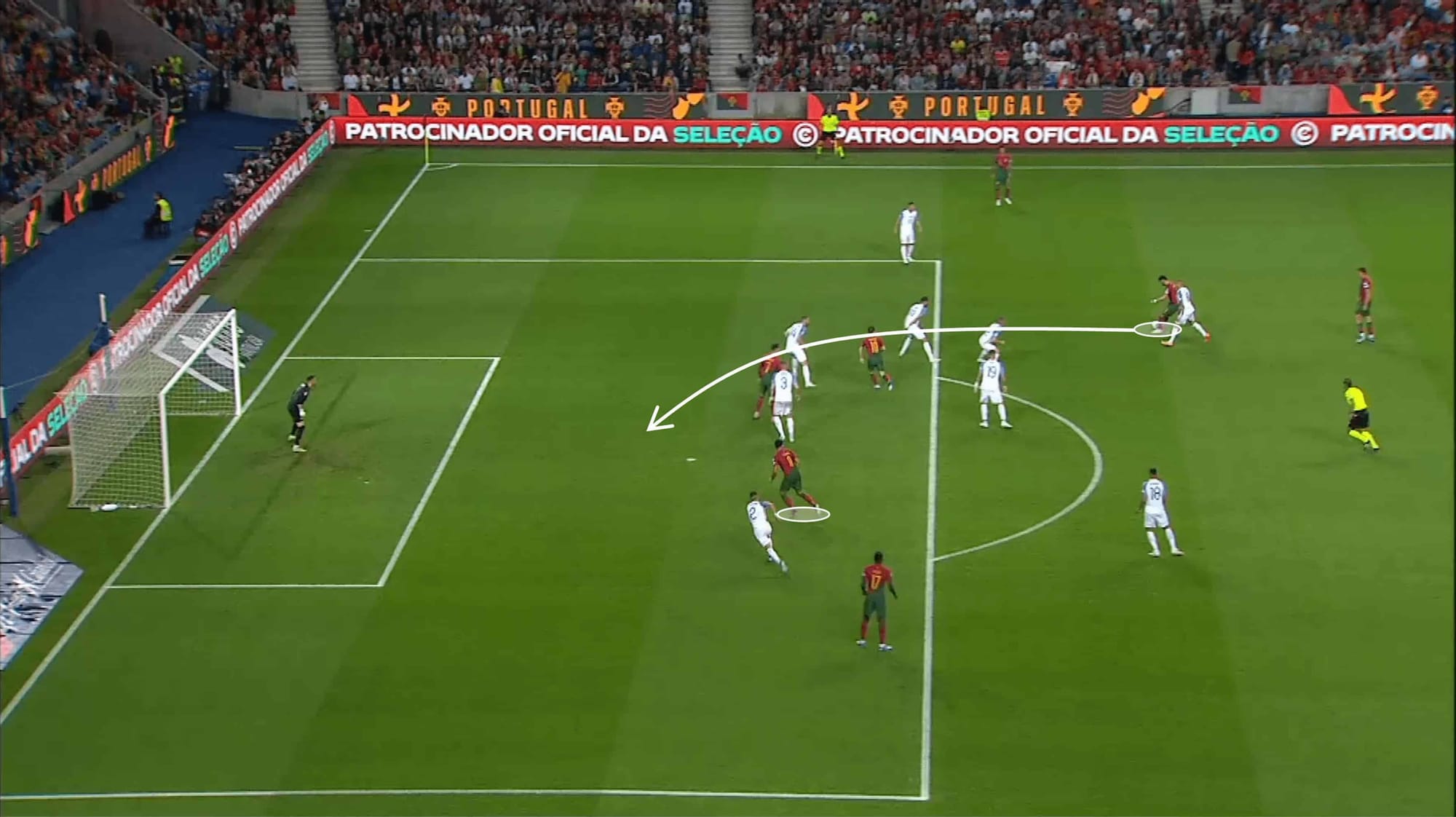
In this example, we see a perfect example of what they are capable of doing when free of marking.
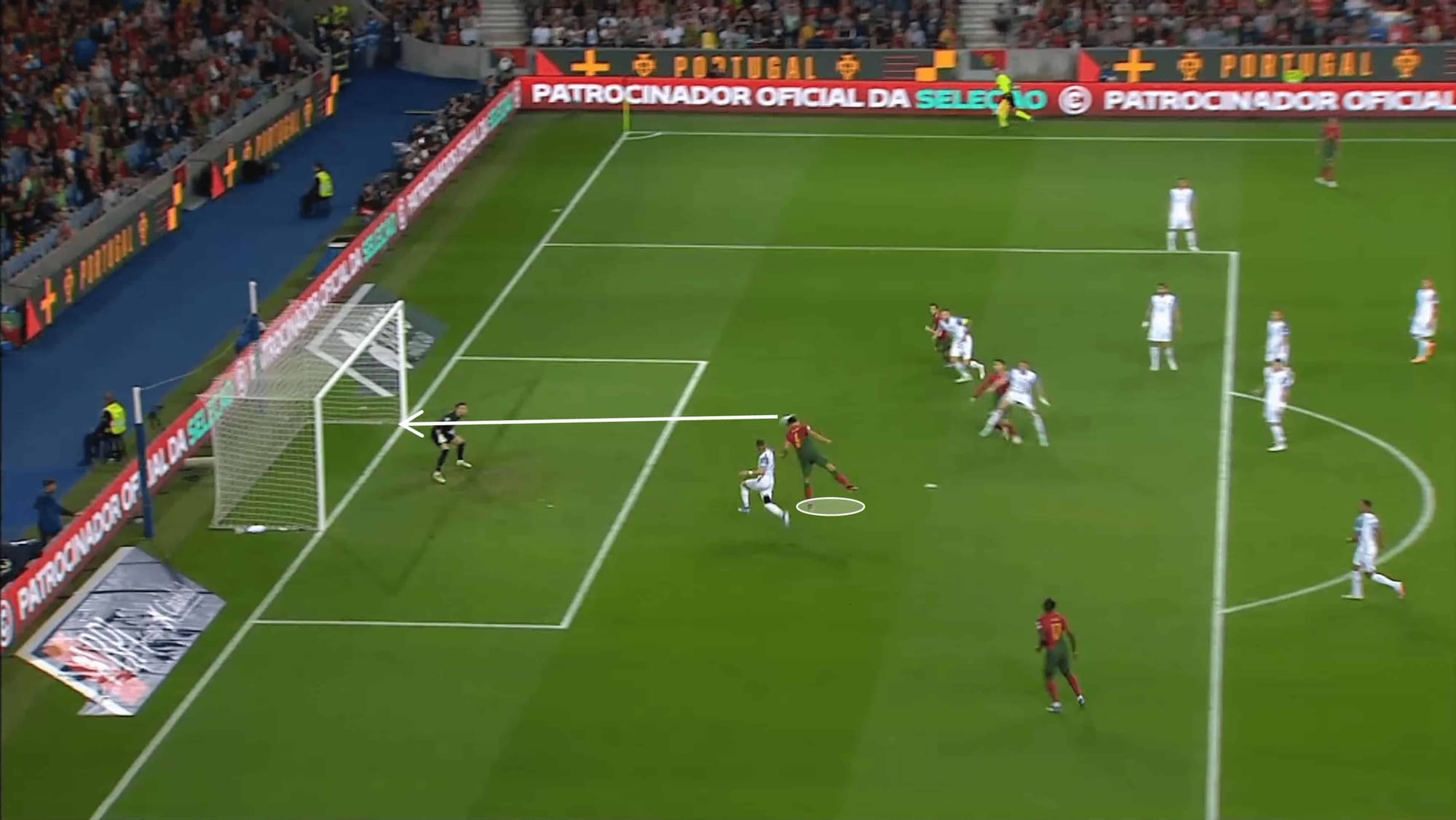
Defensive process
Their defensive solidity has been Portugal’s other highlight, and it isn’t a coincidence. In fact, a lot of work has been done since the former head coach Fernando Santos left, especially in the pressing.
As a matter of fact, Santos’ Portugal often adopted a defensive strategy where they waited for their opponents to make a mistake. Martínez, on the other hand, instructs his players to press in a middle-high block, following a sort of man-to-man marking.
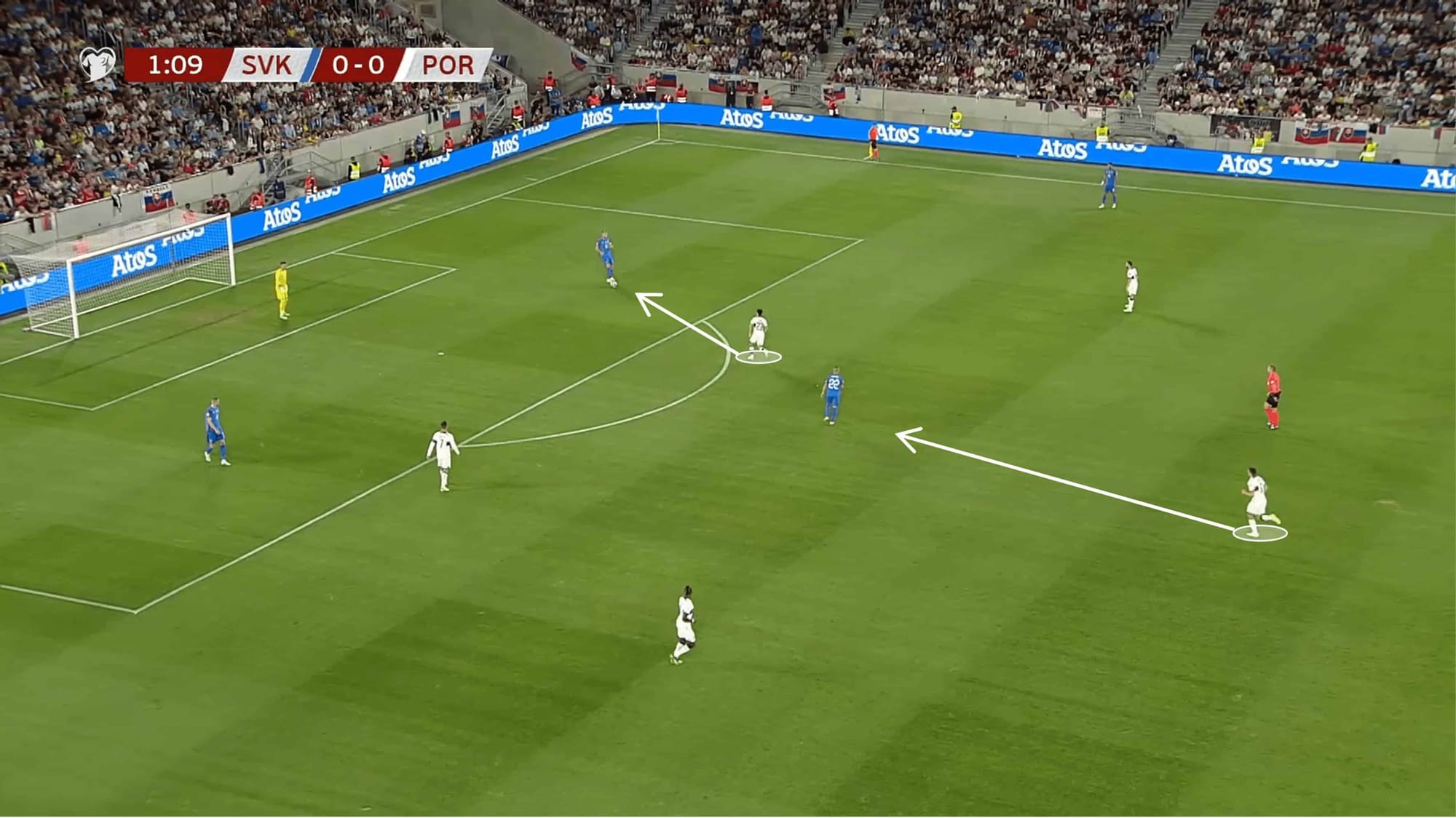
Even though their pressing can have small details which differ from opponent to opponent, for example, if the opposition tends to construct with a three-man line, then Portugal presses in a 4-3-3, as we can see above. Yet, the most used strategy is a 4-4-2 formation since most teams build with two men behind, supported by the pivot, as shown below.
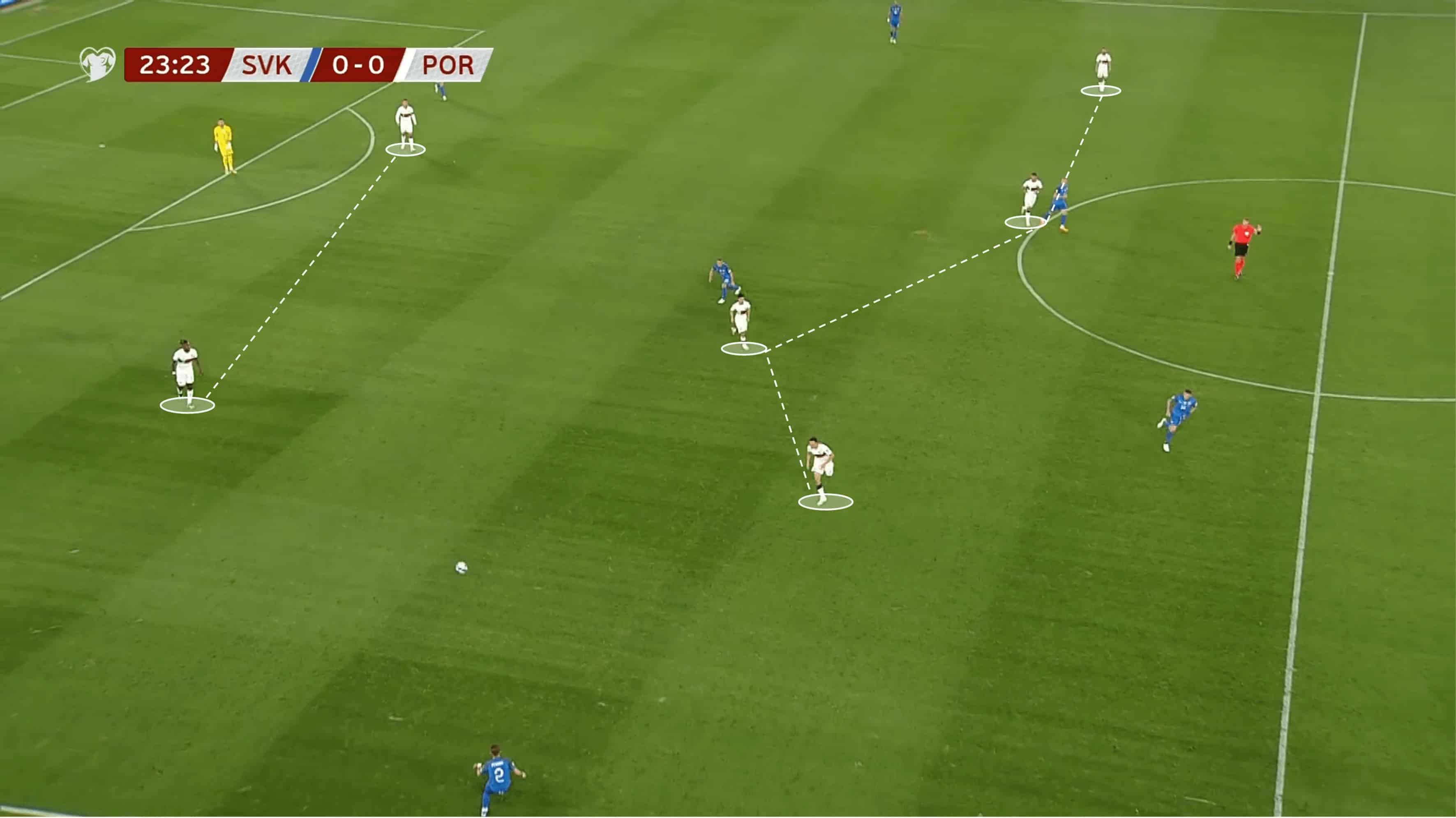
One of the keys to this system’s success is the coordination between their wingers. They decide who will press the centre-back and who will integrate the midfield line.
Portugal’s PPDA (Passes Per Defensive Action) is one of the lowest in this competition (8.7), which clearly indicates Martínez’s defensive philosophy. Moreover, another evidence of Portugal’s dominance while defending is reflected in the below visualisation.
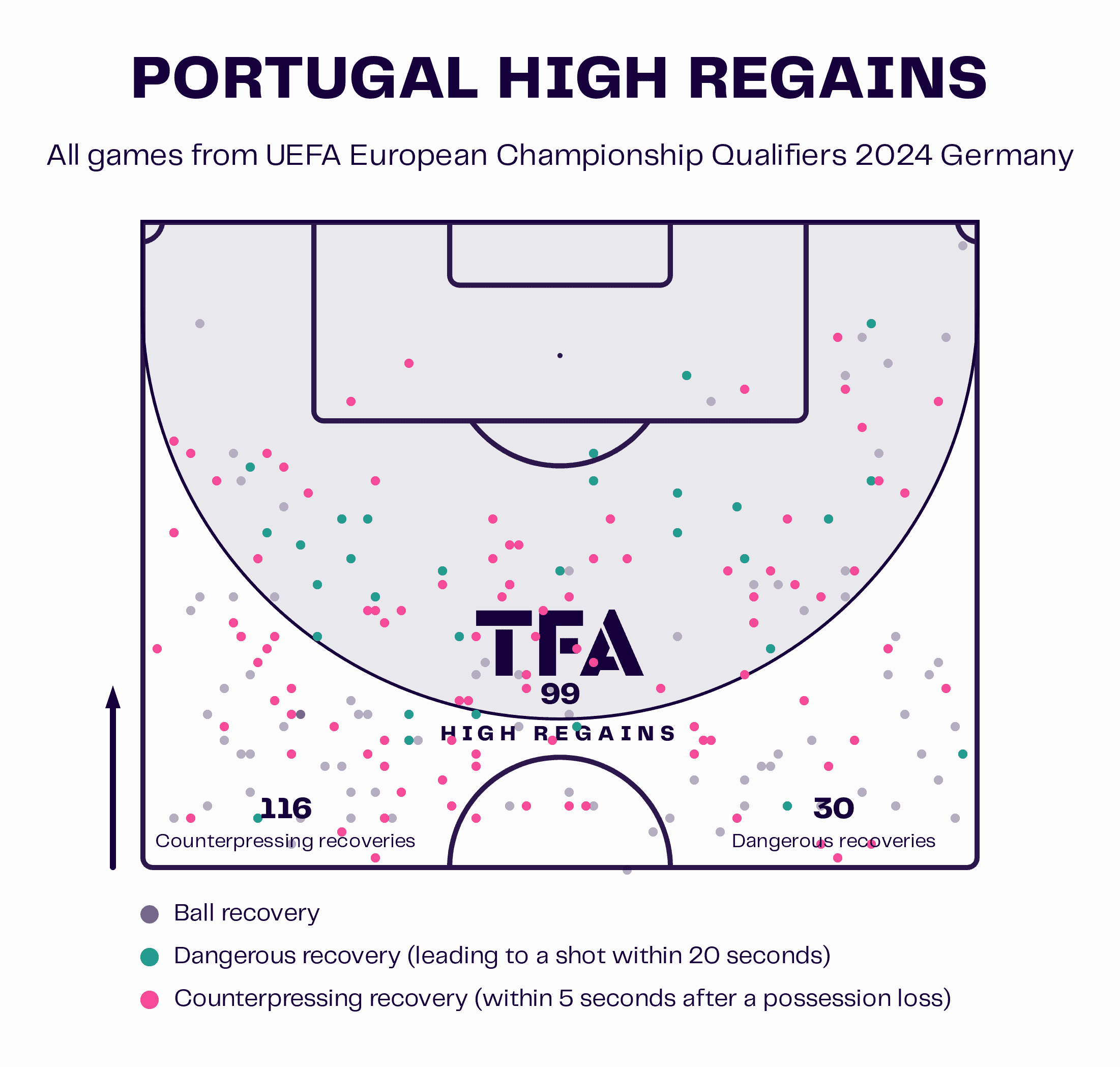
They have 30 dangerous recoveries in their eight UEFA Euro 2024 Qualifiers games. This gives us an average of 3.75 recuperations with a shot in a range of 20 seconds. This image also allows us to understand how Portugal reacts after losing possession. They are a very aggressive and intense team with around 14.5 counterpressing recoveries per game.
João Palhinha has been more recently the pivot with the most minutes, which is essential during this stage. He is characterised by his outstanding defensive game, where he can recover possession repeatedly through his physicality, attitude and aggressive tackles.
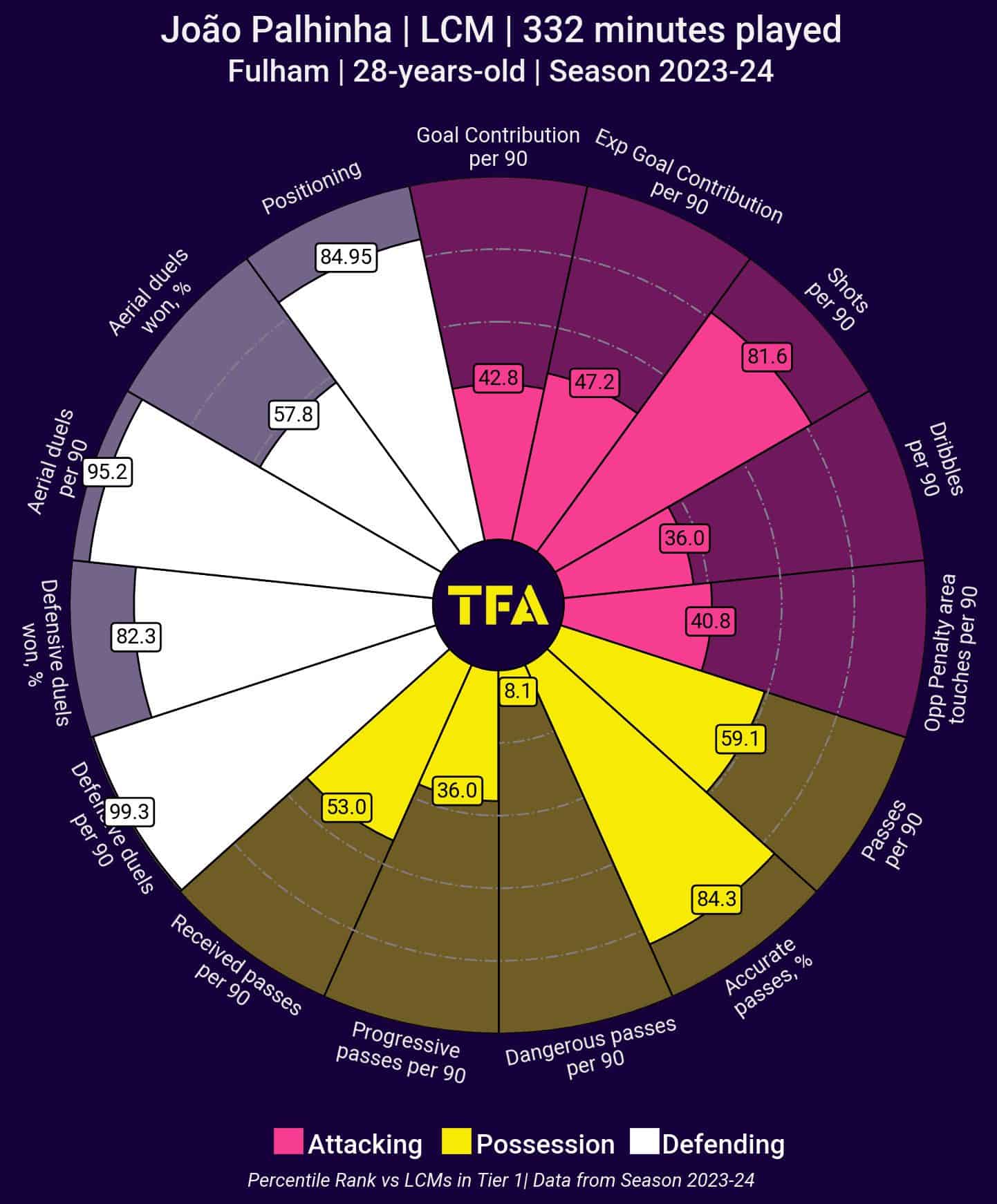
In fact, in the Premier League, he ranked in the 99.3rd percentile on defensive duels and in the 82.3rd on duels won. In a team that exposes that much in the attack, Palhinha will be tremendously valuable while balancing defensively.
We also found it very interesting a small detail related to Rafael Leão’s positioning while pressing. When he’s on his way to press the centre-back, he does an outside-in movement in order to block a passing solution to the full-back.
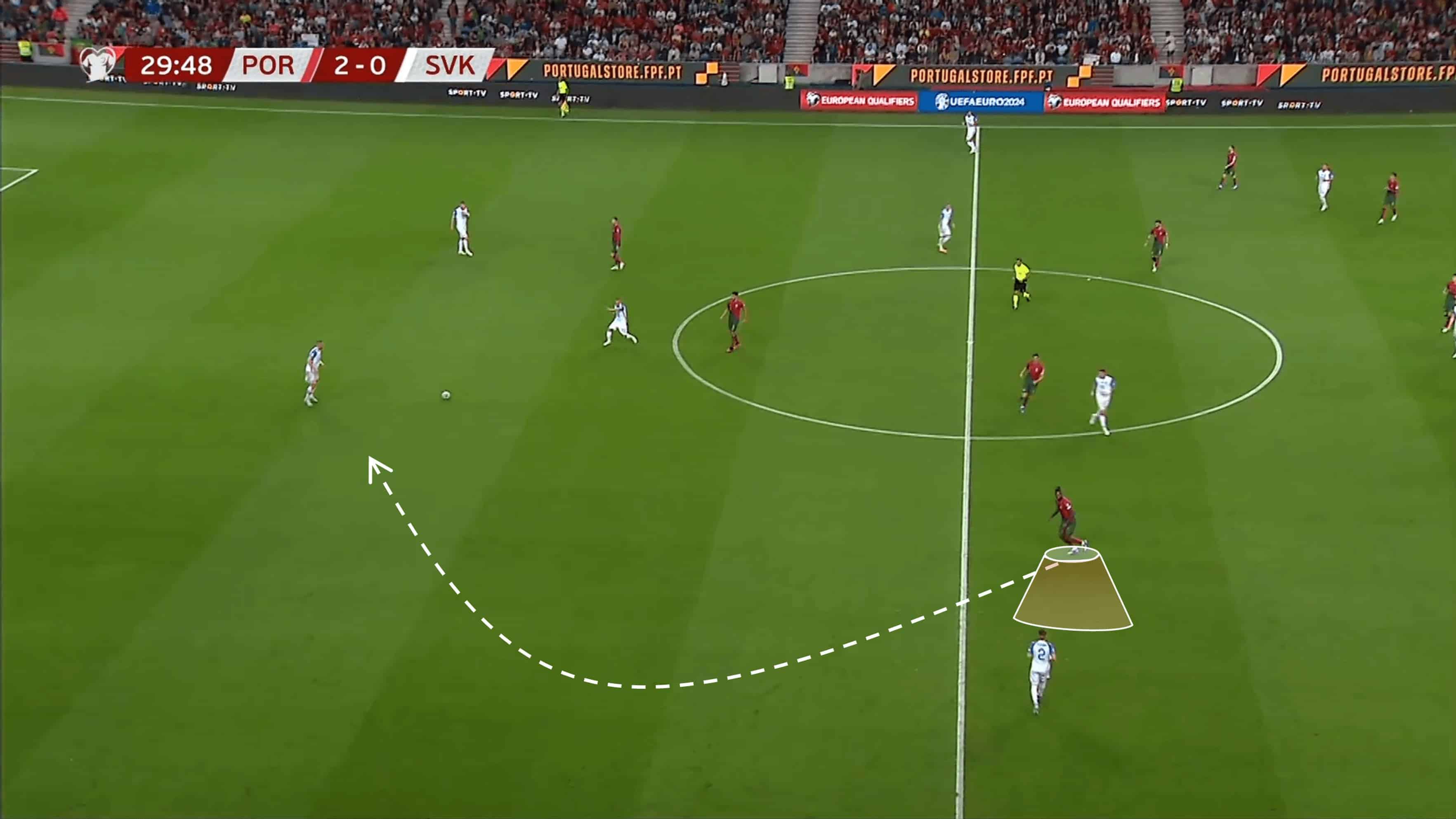
This is important because if the pass isn’t made, the fullback, Dalot, in this case, isn’t forced to leave the backline. A 1v2 situation (Leão against centreback plus fullback), mitigated by a smart pressing strategy, can increase the team’s defensive cohesion.
Finally, we couldn’t leave the goalkeeper and the centrebacks aside from this section. Firstly, Diogo Costa, currently playing in FC Porto, is the world’s most valuable (together with Donnarumma and Maignan) goalkeeper and is taking Rui Patrício’s historical record exceptionally well. He only suffered 10 goals in 17 games disputed and is the present and future choice for securing Portugal’s nets for many years to come.
The back-two is often composed by a duo of Rúben Dias alongside one of the youngsters like António Silva or Gonçalo Inácio. These two are extremely important to their clubs, and Martínez trusts them in the defensive renovation process.
We must also mention the third-most capped player in Portugal’s history: Pepe. Punished with some injuries, the 40-year-old wasn’t regular in the qualifying phase, yet, as we see it, a player with his mentality, technique, and experience will always be an added value to any team in the world.
Conclusion
In an immaculate qualifying phase, Portugal are being sounded as one of the favourites to win the UEFA Euro 2024 title. Yet, it’s worth keeping in mind that the group Portugal was assigned to during the earlier stages of the tournament had considerably lower difficulty than what they will face in the final phase.
In this scout report, we referred that their offensive success had to do with several reasons for their game plan flexibility and ability to link with the most attacking elements easily. Moreover, Portugal also has individualities like Ronaldo, Silva, Fernandes, Leão and Félix, who can suddenly decide a game.
We prioritised João Palhinha, who has been vital in stopping transitions and giving Portugal defensive cohesion. Their detailed pressing plan also significantly impacted their clean sheets, especially by not letting the opposition progress with the ball.

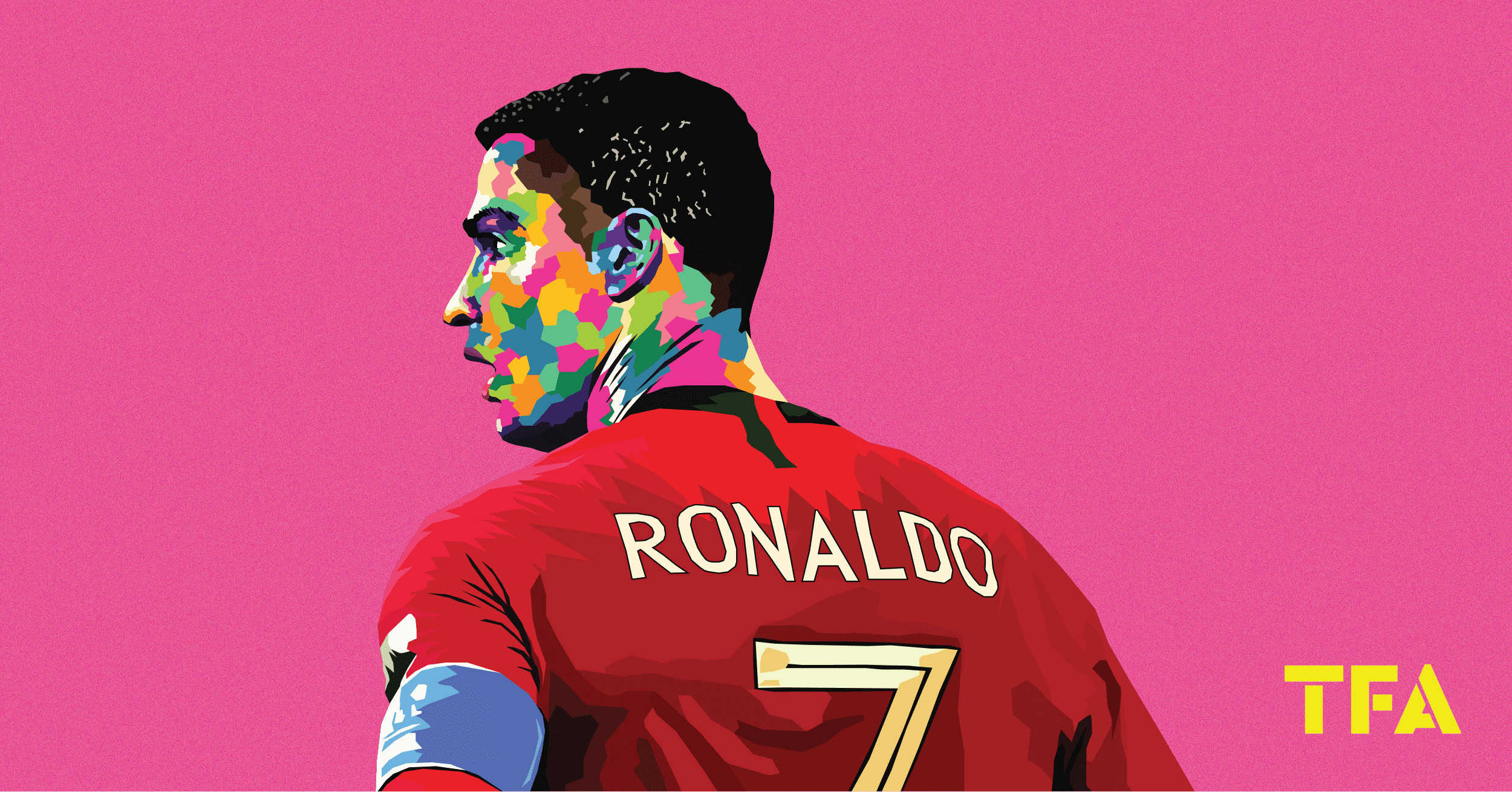




Comments